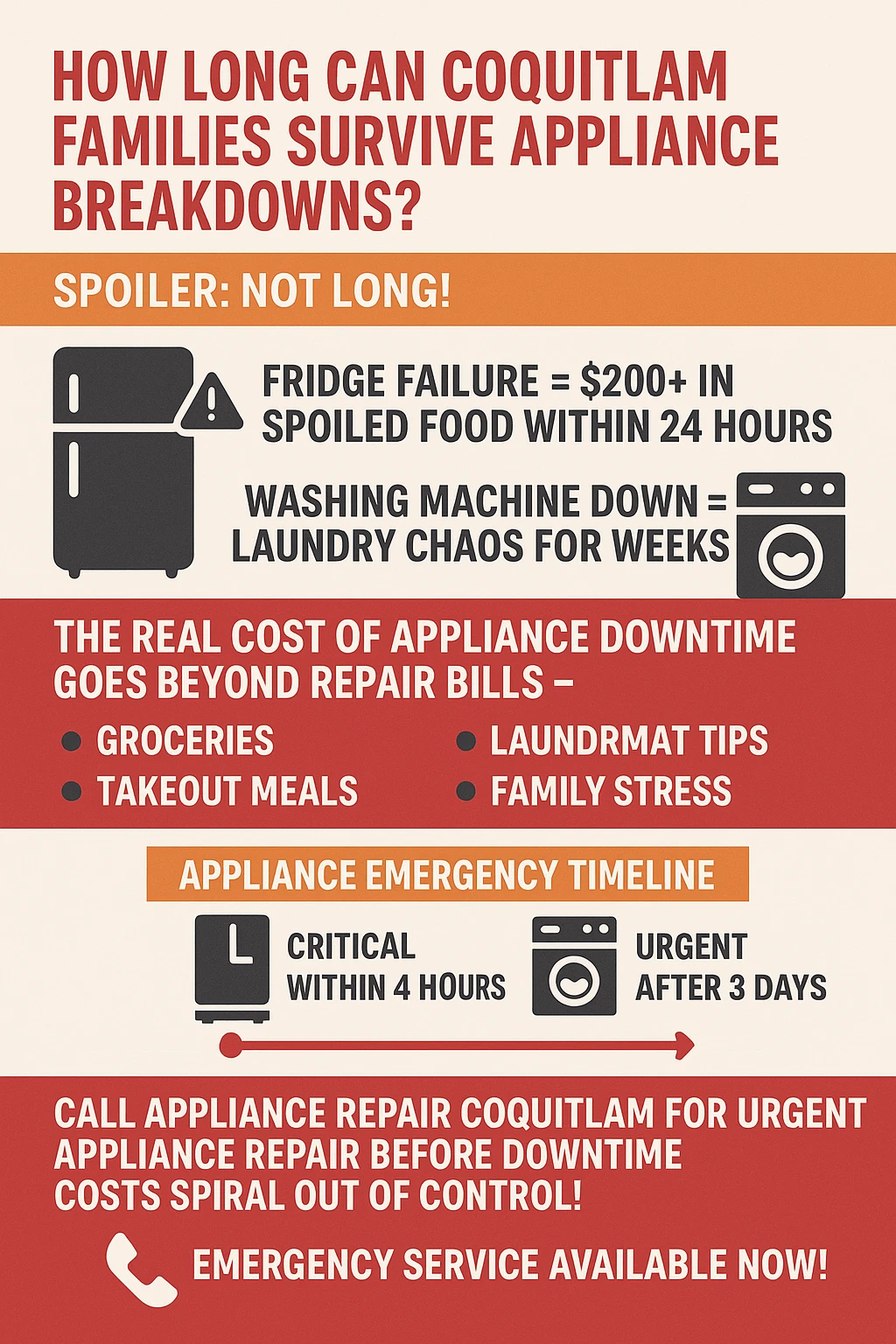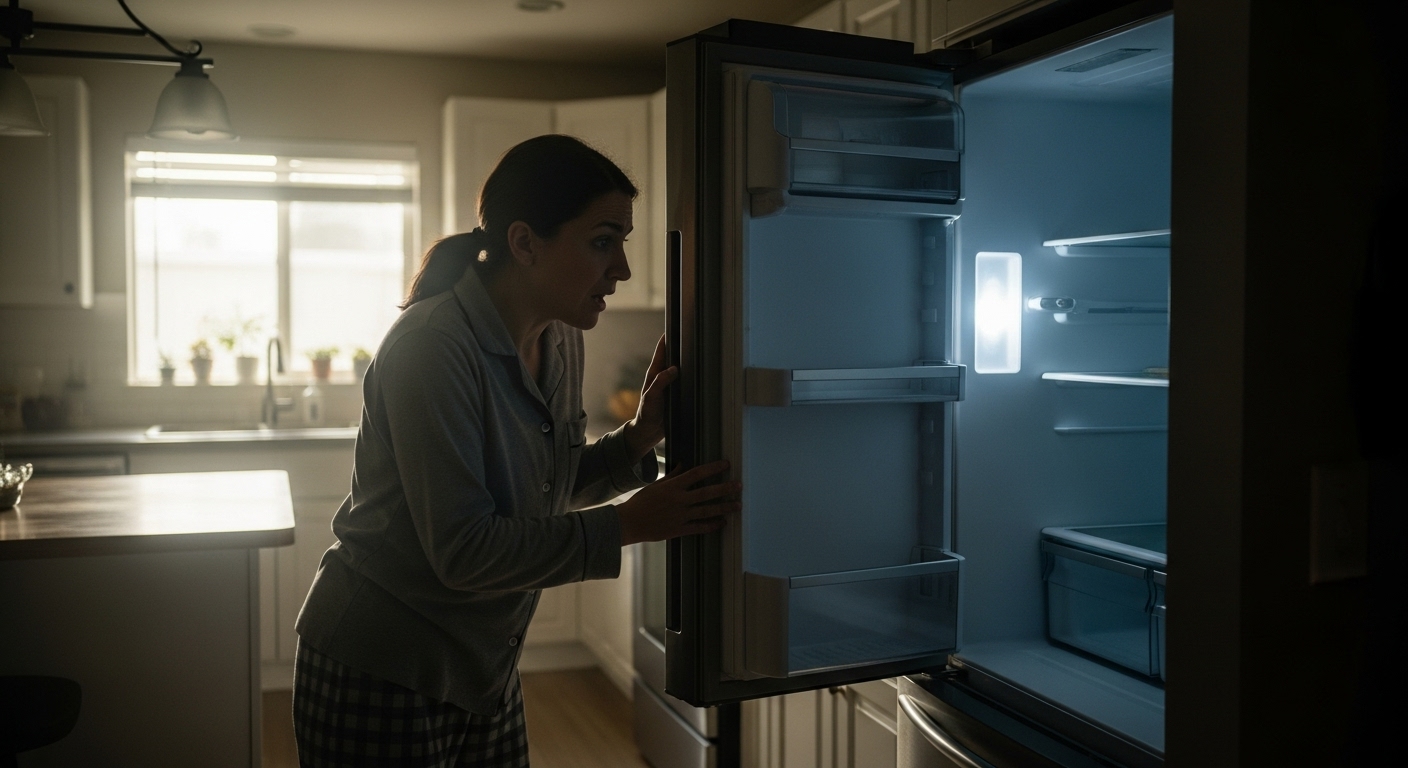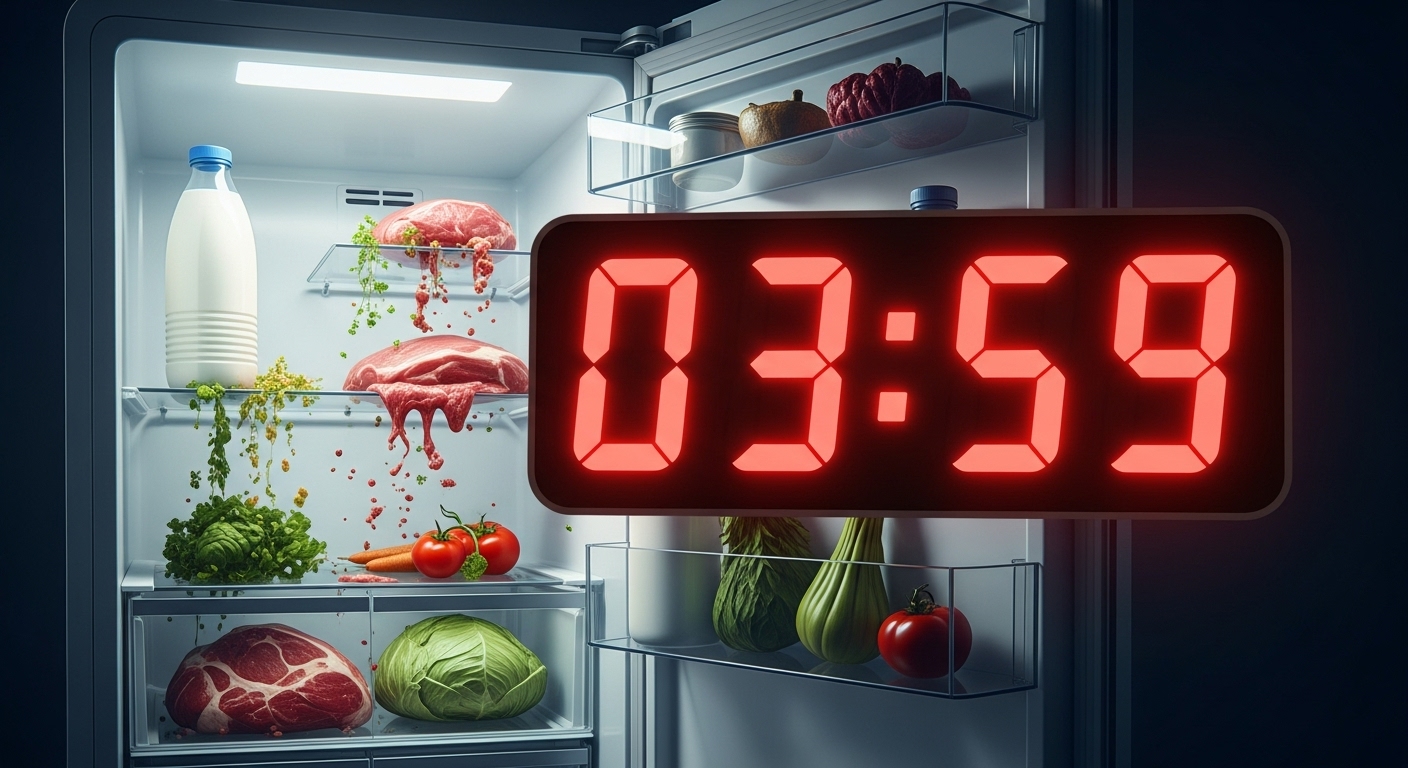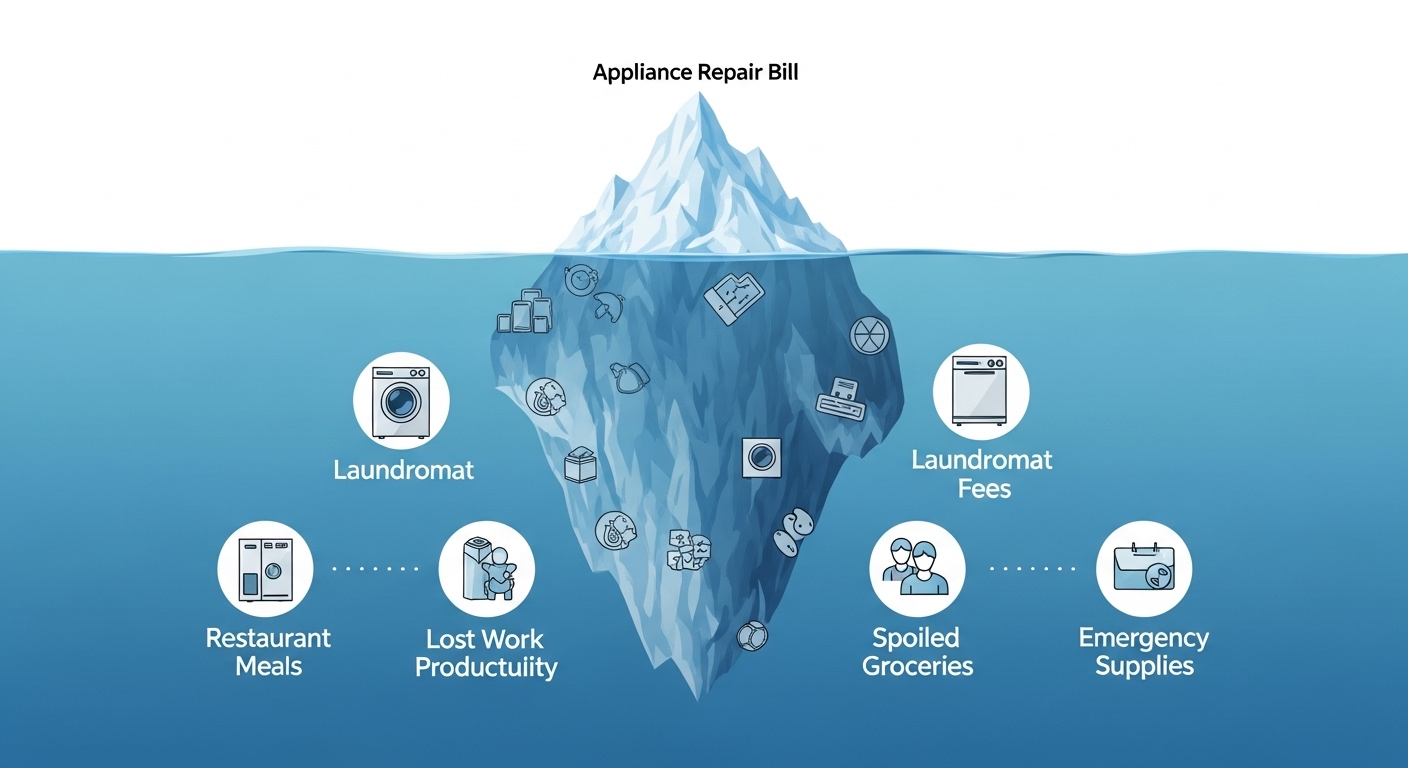The Real Cost of Appliance Downtime: How Long Can Coquitlam Families Go Without Their Essential Appliances?
Ever wondered what happens when your fridge dies at 2 AM or your washing machine floods the laundry room right before a busy week? Let’s explore the real financial and practical impact of appliance breakdowns on Coquitlam families and discover exactly how long you can survive without your essential home systems!
Picture this: you wake up on a Tuesday morning, stumble to the kitchen for your coffee, and realize your refrigerator is suspiciously quiet. No gentle hum, no cool air, and definitely no cold milk for your cereal. Your mind immediately races – how much food will spoil? How much will this cost? Can I wait until next week for a repair appointment?
If you’re like most Coquitlam homeowners, appliance breakdowns feel like they happen at the worst possible moments. That’s because modern families rely on 8-10 major appliances daily, yet most of us are completely unprepared for the cascading consequences when these essential systems fail. From spoiled groceries to emergency laundromat trips, the true cost of appliance downtime extends far beyond simple repair bills.
What makes this even trickier for local families is that our Pacific Northwest climate and busy lifestyle create unique challenges. Higher humidity can accelerate appliance wear, emergency repairs cost significantly more than scheduled service, and finding reliable technicians during peak seasons can take days. Understanding these realities helps you make better decisions when disaster strikes – and trust me, it’s not a matter of if, but when.
Key Outtakes:
- Refrigerator failure creates a health emergency within 4 hours, with families losing an average of $100-300 in spoiled food during extended outages
- Emergency appliance repairs in the Vancouver area cost 20-50% more than scheduled service, with same-day premiums adding $50-200 to standard rates
- Modern washing machines last only 10.6 years compared to 19.2 years historically, making breakdowns more frequent and urgent for busy families
- The hidden costs of appliance downtime – including restaurant meals, laundromat fees, and productivity losses – often exceed the actual repair bill
- Strategic preparation with backup plans and reliable repair contacts can reduce both financial impact and lifestyle disruption during appliance emergencies

The Critical Timeline: When Inconvenience Becomes Crisis
Understanding the urgency timeline for different appliance failures is absolutely crucial for making smart decisions during breakdowns. Not every appliance failure requires panic-mode emergency service, but some definitely do. Let me break down the critical windows where delay becomes dangerous or expensive.
When your refrigerator stops working, you’re literally racing against the clock for food safety. According to the CDC guidelines, refrigerated food becomes unsafe for human consumption after just 4 hours without power. Your freezer buys you more time – a full freezer maintains safe temperatures for approximately 48 hours, while a half-full freezer only lasts 24 hours. This isn’t just about wasting groceries; spoiled food can cause serious foodborne illness that sends families to the emergency room.

The financial impact hits immediately too. Studies show the average American family already discards $53.81 worth of spoiled food weekly under normal conditions. When your fridge dies, you’re looking at losing $100-300 worth of groceries for a fully stocked unit, plus the cost of emergency ice, coolers, and possibly eating out until repairs are complete. I’ve seen families spend more on managing a fridge breakdown than they would have on same-day repair service.
Washing machine failures create a different kind of urgency. Modern families do laundry about 8 times per week compared to twice weekly in 1960, meaning a broken washer impacts your routine within 24-48 hours. After 3-4 days, you’re looking at emergency alternatives like professional laundry services at $15-25 per load, which can cost $120-200 weekly for an average family. The math gets even worse if your machine is flooding – water damage can easily reach $2,000-10,000 if not addressed promptly.
Dishwasher breakdowns seem less urgent until you realize the hidden costs. Hand-washing dishes uses 27 gallons of water compared to just 4 gallons for machine washing, increasing your utility bill by 575%. For families doing multiple loads daily, this adds up fast. Plus, the time investment is significant – what takes 10 minutes with a dishwasher becomes 45 minutes of hand-washing and drying.
Here’s something most people don’t realize: there’s a psychological phenomenon I call “cascading appliance failure syndrome.” Research shows that 40% of kitchen appliances get replaced simultaneously during renovations, often because one failure creates pressure to upgrade everything. This domino effect can turn a simple $200 repair into a $5,000+ kitchen overhaul, which is why understanding true urgency levels is so important.
The Hidden Economic Impact Beyond Repair Bills
Most families focus only on the repair estimate when their appliances break down, but that’s just the tip of the iceberg. The real financial impact includes emergency service premiums, alternative solutions, productivity losses, and opportunity costs that can easily double or triple your total expense.

Let’s start with emergency repair premiums. In the Vancouver area, same-day and after-hours service typically costs 20-50% more than scheduled appointments. Standard appliance repairs range from $100-400, but add weekend or evening service and you’re looking at an extra $50-200 in premium fees. During peak seasons like summer for AC repairs or winter for heating systems, these premiums can increase even further due to high demand and limited technician availability.
The alternative service costs really add up too. When your stove breaks, families spend an average of $40-60 daily on restaurant meals compared to $15-20 for home-cooked food. Over a week-long repair timeline, that’s an extra $175-280 in food costs. Add laundromat fees, ice for coolers, paper plates and cups, and other temporary solutions, and you’re easily looking at $300-500 in indirect costs for a major appliance breakdown.
Then there’s the productivity impact that nobody talks about. Business downtime costs average $427 per minute for small enterprises, and household appliance emergencies create similar productivity losses through schedule disruption, childcare complications, and work-from-home challenges. Families typically spend 4-6 hours managing appliance emergencies – calling repair services, dealing with water damage, finding alternative solutions, and coordinating schedules. That represents $100-150 in lost productivity time based on average hourly wages.
Seasonal amplification makes everything worse and more expensive. Summer air conditioning failures and winter heating breakdowns create genuine emergency situations requiring premium service rates. Spring moving season increases appliance installation delays by 2-3 weeks, while holiday periods limit technician availability. Canadian appliance failures during peak seasons can cost 30-50% more than off-peak repairs due to increased demand and reduced service availability.
Insurance considerations add another layer of complexity. Equipment breakdown coverage can protect against losses up to $50,000, but most homeowners don’t understand what’s covered or how to file claims effectively. The key is documenting everything – photos, receipts, repair estimates – because insurance companies require detailed proof of losses and alternative expenses during the claims process.
Emergency vs. Scheduled Repair: Making Smart Triage Decisions
Not every appliance breakdown requires emergency service, and understanding the difference can save you hundreds of dollars while ensuring you respond appropriately to genuine emergencies. I’ve developed a three-tier system that helps families make smart triage decisions during stressful appliance failures.

Tier 1 represents genuine health and safety emergencies that require same-day service regardless of cost. This includes refrigerator and freezer failures that threaten food safety, gas appliance leaks that pose explosion or poisoning risks, and electrical malfunctions that could cause fires. These situations justify premium emergency service rates because delay costs significantly exceed the extra service charges. Gas appliances pose particular complexity, typically requiring 20% more repair time and specialized safety protocols.
Water-related failures also fall into emergency territory when they’re causing active damage. A washing machine that’s flooding your laundry room, a dishwasher leaking onto hardwood floors, or a water heater spraying hot water needs immediate attention. Water damage restoration can easily cost $2,000-10,000 if not addressed within 24-